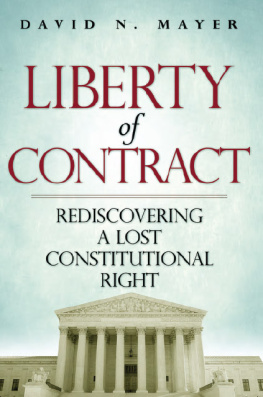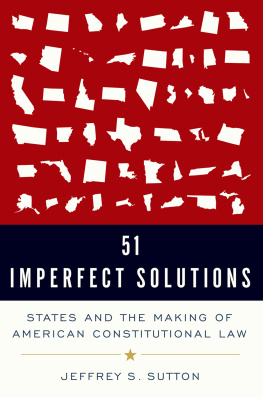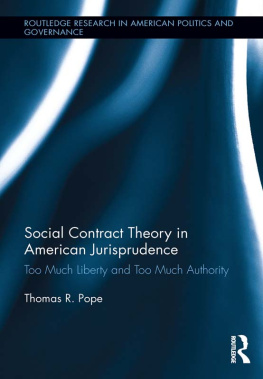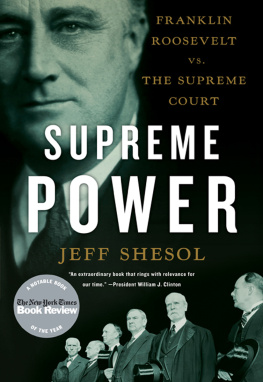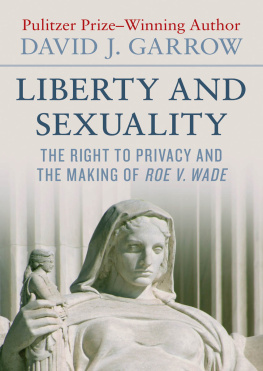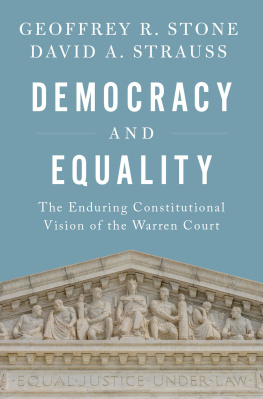

Copyright 2011 by the Cato Institute.
All rights reserved.
Library of Congress Cataloging-in-Publication Data
Mayer, David N.
Liberty of contract : rediscovering a lost constitutional right / by David N. Mayer. p. cm. ISBN 978-1-935308-38-6 (hardback : alk. paper) ISBN 978-1-935308-39-3 (pbk. : alk. paper) 1. Liberty of contractUnited States. I. Title.
KF801.M29 2011 346.7302dc22 2010045597
Printed in the United States of America.
CATO INSTITUTE
1000 Massachusetts Ave., N.W.
Washington, D.C. 20001
www.cato.org
Introduction: The Myth of Laissez-Faire
Constitutionalism
Is an employee in a bakery free to work as many hours as he and his employer agree to, in order to earn more money for himself or his family? May a female hotel elevator operator choose to accept part of her wages in the form of room and board? Is the owner of a new business free to enter a market and compete with established companies? Do homeowners have the right to sell their houses to whomever they wish, despite a city ordinance forbidding them from selling to someone of a different race? May parents choose to have their children taught in a language other than English, and may a teacher earn his living by instructing non-English-speaking students? Or are parents free to choose to send their children to a private school, whether a parochial school or a private military academy, and are such private schools free to compete with government schools?
At one time in American history, the United States Supreme Court answered yes to each of the above questions, protecting as a constitutional right something known as liberty of contract. Exercising its power of judicial review, 1 the Court declared unconstitutional various state and federal laws that abridged this liberty by denying individuals the freedom to bargain over the terms of their own contractsmaximum-hours laws, minimum-wage laws, business-licensing laws, housing-segregation laws, and compulsory-education lawslaws that interfered with individuals liberty of contract in each of the above-mentioned cases.
For a period of exactly 40 years, from 1897 until 1937, the Supreme Court protected liberty of contract as a fundamental right, one aspect of the basic right to liberty safeguarded under the Constitutions due process clauses, which prohibit governmentthe federal government, under the Fifth Amendment, and states, under the Fourteenth Amendmentfrom depriving persons of life, liberty, or property without due process of law. 2 Because the Court protected liberty of contract by evaluating how laws limited persons libertythe substance of the laws themselves, as distinct from the procedures by which laws were enacted or enforcedmodern constitutional law scholars consider liberty of contract to be a form of substantive (as opposed to procedural) due process. 3 Although the Supreme Court continues to use substantive due process to protect certain aspects of libertymost of the rights enumerated in the Bill of Rights plus other personal rightsfollowing its New Deal Revolution of 1937, it ceased protecting liberty of contract, a right it had first explicitly recognized merely 40 years before. 4
No period in American constitutional history is more misunderstood than this 40-year stretch. Known as the Lochner era , it is named for the best-known U.S. Supreme Court decision protecting liberty of contract, Lochner v. New York . 5 The Courts protection of liberty of contract during this period is often described as economic substantive due process, both to emphasize the most famous line of Lochner -era decisionsthose protecting economic liberty against restrictive labor legislationand to distinguish the Courts use of substantive due process during that period from its use in the modern, postNew Deal era. 6 The phrase economic substantive due process is just one of the misleading labels commonly used to describe the era. Other, even more misleading, terms are used by modern scholars to describe both Lochner and the Lochner era.
Most modern legal scholars condemn the Lochner decision as an egregious instance of judicial activismof judges making new law rather than interpreting and applying the existing rules of law: in other words, of judges reading their own policy preferences into the law. Indeed, Lochner is commonly regarded by legal scholars as the archetypical activist decision of the Supreme Court: shorthand in constitutional law for the worst sins of subjective judicial activism, as Aviam Soifer puts it. Nothing can so damn a decision as to compare it to Lochner and its ilk, observes Michael Les Benedict. The decision has even prompted some scholars to invent a new verb: We speak of lochnerizing when we wish to imply that judges substitute their policy preferences for those of the legislature, writes William Wiecek. 7
Modern scholars also refer often to the early 20th century as the era of laissez-faire constitutionalism because they see it as a time when judges injected a radical libertarian, or laissez-faire, philosophy into their constitutional decisions. Indeed, the stereotypical view sees the Lochner era as a time when American judges, motivated by the desire to further the interests of rich capitalists, perverted the original meaning of the due process clauses in order to engraft a laissez-faire ideologycommonly caricatured as synonymous with the doctrines of Social Darwinismon the Constitution. 8 This view so dominates modern scholarship that it is the orthodoxy of college textbooks, both the casebooks used in law school constitutional law classes and the textbooks used in undergraduate and graduate courses in constitutional and legal history. 9 The orthodox view is found in constitutional commentaries written by both conservatives and liberals, 10 and even in opinions written by modern Supreme Court justices. 11
The modern view originated in legal scholarship written during the Progressive Era in the early 20th century. Progressivism arose at that time as a reform movement involving a diverse coalition of Americans who shared the conviction that government at all levels should play an active role in regulating economic and social life.12 Progressive Era scholars and jurists such as Roscoe Pound, Learned Hand, and Charles Warren were not neutral in their analysis of liberty of contract. Rather, as supporters of the Progressive movement, they were hostile to the individualist philosophy that they perceived in the courts protection of liberty of contract, and their personal hostility to the philosophy colored their criticism of the jurisprudence.13 Learned Hand, for example, was a major... figure and a true believer in the Progressive movement, according to his biographer. 14 Indeed, as an advocate of maximum-hours, minimum-wage, and workers compensation legislation, Hand was especially critical of judicial decisions invalidating such legislation; he even suggested total repeal of the due process provisions of the Fifth and Fourteenth Amendments to strip the courts of their power to protect liberty of contract. 15 Modern scholars who interpret Lochner or the Lochner era by relying mainly or even exclusively on the views of such partisans as Pound, Hand, or Warren have made the same kind of mistake that future historians would make were they to similarly rely on the views of, say, the National Right to Life Committee to interpret Roe v. Wade. 16
Although propounded by Progressive-Era scholars, the modern view of the Supreme Courts Lochner -era jurisprudence can be traced back originally to a misconception by Justice Oliver Wendell Holmes Jr., in his famous dissent in Lochner . Holmes characterized the majoritys opinion as having been decided upon an economic theory which a large part of the country does not entertain, adding the oft-quoted pithy comment, The 14th Amendment does not enact Mr. Herbert Spencers Social Staticsa reference to the most famous laissez-faire treatise of the time. He then explained,

